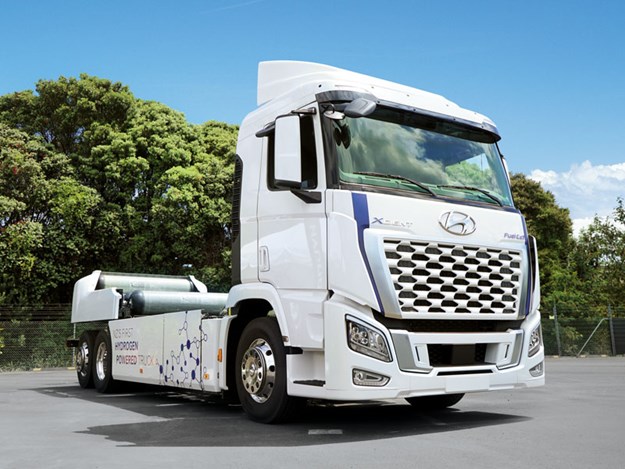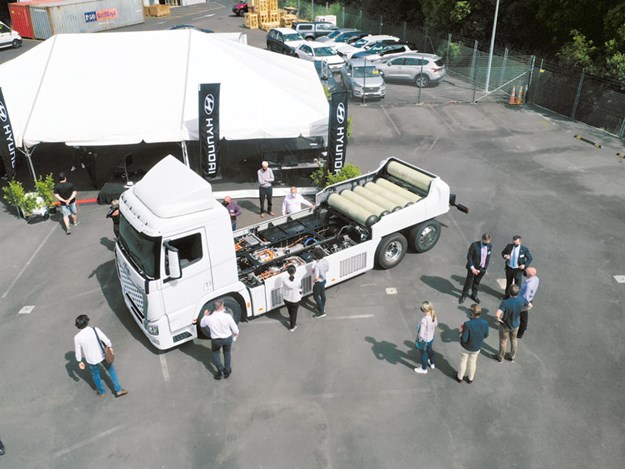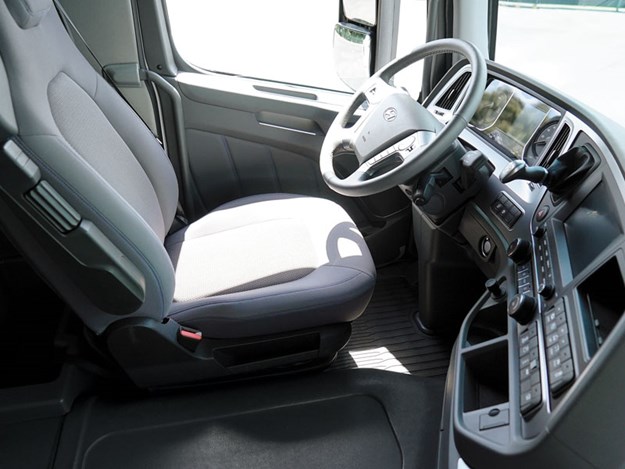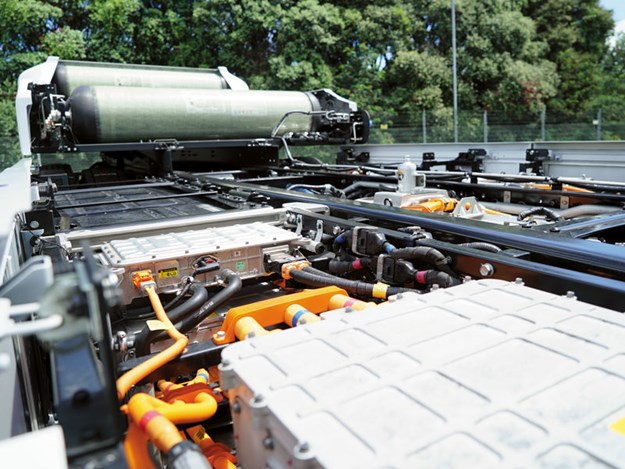Cover story: Hyundai XCIENT
The first of five hydrogen-powered XCIENT heavy-duty cab and chassis unit have been delivered to Hyundai's Mt Wellington base
 |
|
NZ is the third country to receive a hydrogen-powered Hyundai truck
|
It appears Christmas arrived early to the house of Hyundai, akthough, there will need to be a pretty tall Christmas tree if it's going to have a 10,200kg present fit under it.
The ‘present’ I refer to arrived in the form of New Zealand’s first hydrogen-powered Hyundai XCIENT heavy-duty cab and chassis unit, which is the first of an order of five, with the next four vehicles due to arrive in the country in the first quarter of next year.
New Zealand will be the third country behind Switzerland and Korea to introduce the cutting-edge technology of FCEV (Fuel Cell Electric Vehicles) to its heavy transport sector.
 |
|
Media attended the launch held over three sessions
|
A recent media launch was held at Hyundai New Zealand headquarters in Auckland and was split into three sittings. Each session was limited to 25 attendees, comprising Parliamentarians, associated industry personnel, and media to comply with current COVID-19 regulations, with the 12:10pm session being live-streamed on YouTube.
 |
|
New tech, which will soon become familiar
|
Following an introduction given by Hyundai’s communications manager Kimberley Waters, Hyundai NZ’s CEO Andy Sinclair spoke briefly of the company’s commitment to implementing alternative fuel technology in New Zealand in what he described as the "shift in the energy paradigm away from fossil fuel to hydrogen."
Andy exemplified this philosophy by pointing to New Zealand’s first hydrogen-powered SUV, the Hyundai NEXO, which was also on display at the launch. Both vehicles are the result of 20 years of extensive research and development into hydrogen power by Hyundai.
At one point in the proceedings, a noisy vehicle passed by and drowned-out Andy’s voice. The perfect timing of this unplanned happening provided him with an ideal chance to extol just one of the advantages of hydrogen-powered trucks—its quietness.
Hydrogen chemistry lesson
Gavin Young, Hyundai NZ’s technical manager presented an easy-to-understand overview of the production of hydrogen power, along with a short chemistry lesson as a precursor to the walkaround which was to follow a short time later.
Hyundai NZ says the electric traction motor, with max power of 350kW and max torque of 2237Nm, is powered by two 90kW fuel cell stacks supported by a 72kWh (630 volt) Lithium Polymer Battery.
The electricity generated from the fuel cell stacks power the electric traction motor and recharges the high voltage battery. This is a result of an electro-chemical reaction, which involves hydrogen gas and oxygen from the ambient air.
The only by-product of this reaction is water vapour. Essentially, power is created through an electrochemical reaction inside a fuel cell of which up to 400 can be stacked. Apparently, one cell can produce up to one volt of electricity.
Each cell when described as a sandwich: on one side of a fuel cell, hydrogen gas (H2—two atoms) is fed through a negatively charged anode, which separates the gas into two separate hydrogen atoms, enabling the two now individual negatively-charged atoms to pass through a catalyst (sandwich filling)—or more— correctly called a polymer electrolyte membrane or proton exchange membrane (PEM).
Meanwhile, on the other side of the sandwich, ambient air (containing oxygen) is fed into the positively charged cathode side. The movement of the negatively charged hydrogen atoms through the PEM to the cathode side creates a small electrical charge, which when collected from all the fuel cells is used to run the Hyundai XCIENT’s 350kW electric traction motor. And, of course, the spent hydrogen after being used has combined with the oxygen, giving us what we all know as water.
Hyundai XCIENT walkaround
The hydrogen 101 masterclass was followed by a presentation given by Grant Doull, who holds the lengthy job title of manager—hydrogen and eco commercial vehicles, Hyundai New Zealand. His section included items such as loading specifications and where components sat within the truck.
Grant’s explanation of the part each component played in bringing power to the wheels and where each unit was ‘packaged’ on the vehicle was invaluable in making sense of what the guests were looking at when they finally got to eyeball the machine first-hand.
The presentation section of the afternoon’s event concluded with a Q+A session and a truck walkaround. This gave attendees the opportunity of getting up close and personal with the vehicle, along with an opportunity to photograph the truck’s componentry and to see and (barely) hear it do several circuits of Hyundai’s Mt Wellington yard.
While the bright white-cabbed, left-hand drive truck was able to be fuelled from a fuelling station at the Ports of Auckland and driven to Mt Wellington, Hyundai NZ’s technicians clearly have a lot of work ahead of them before the truck can be configured for on-road use in this country.
 |
|
The truck will be converted to right-hand drive
|
The first two visually apparent tasks ahead are the conversion to right-hand drive and to elevate the hydrogen tanks to their rightful position, sitting vertically behind the cab.
 |
|
The hydrogen tanks were placed horizontal for shipping purposes
|
When correctly positioned upright, the cradle that houses the tanks, like a giant wine bottle rack, appears to have a twofold purpose: firstly, of course, to carry the cylinders and, secondly, to complete an arc in order to integrate it with the airfoil on the cab.
It’s easy to imagine that when a box or curtain-sider body is fitted, the visual appearance of the truck viewed at the media launch will change considerably. A further enhancement of the overall look, not to mention the aerodynamics of the vehicle, will be provided by the coaming panels already fitted to the truck. These again play a dual role in not only protecting components but also that of improving airflow.
Under the hood
.jpg)
More precisely, under the cab and between the chassis rails can be found a multiplicity of componentry, which in the main appears alien to anybody who’s accustomed to tilting the cab of a diesel-powered truck.
That is with the exception of the Allison six-speed automatic transmission (partly obscured by a maze of indescribable pipework and valves), a conventional power steering box, and a final drive; the remainder of the paraphernalia gives the appearance of being the stuff of scientists.
.jpg)
The truck viewed at the launch and the four vehicles that are to follow have been supplied to Hyundai New Zealand in European 6x2 configuration, fitted with a steering tag axle.
The GVM (Gross Vehicle Mass) and GCM (Gross Combined Mass) of 28,000kg and 42,000kg respectively may be downrated to comply with New Zealand standards.
The first of these trucks will be on the road in the second quarter of next year, in a live field trial transporting large volumes of goods commercially across New Zealand. Hyundai New Zealand proudly states that it is a founding member and the first automotive brand to join the NZ Hydrogen Council in 2018.
Hyundai XCIENT specifications
|
Configuration |
6x2 with steering tag axle |
| Hydrogen tank | 31kg (350 bar) |
| Battery | 72 kWh (24kW x 3) |
| Fuel stack | 180kW (90kW x 2) |
| Range | 400km |
| Refuel time | 8–20 min |
| Electric motor | 350 kW |
| Max torque | 2237Nm |
| GVM | 28,000kg |
| GCM | 42,000kg |
| Emissions | Zero |
| CO2 saving PA | 50T est. |
For more information, visit hyundai.co.nz/fuel-cell-truck.
Find new and used trucks for sale in NZ
Keep up to date in the industry by signing up to Deals on Wheels' free newsletter or liking us on Facebook.





.jpg)


.jpg)


.gif)
.gif)
.gif)
.gif)


